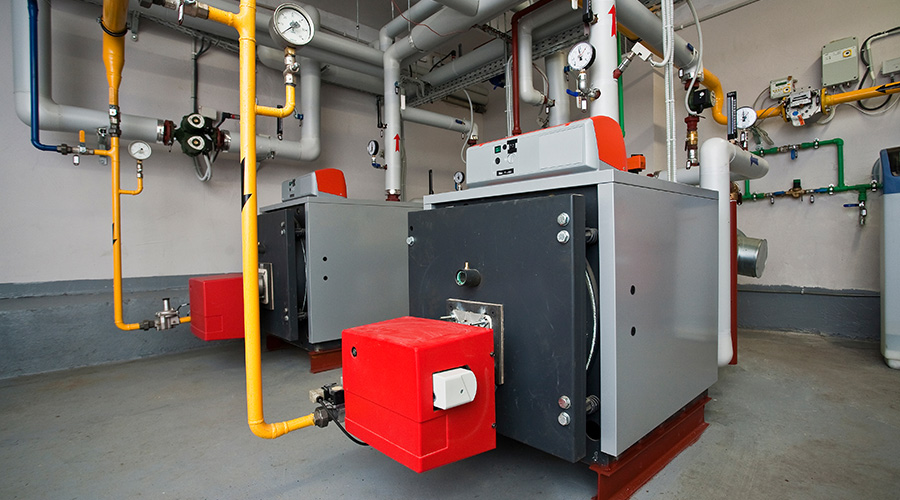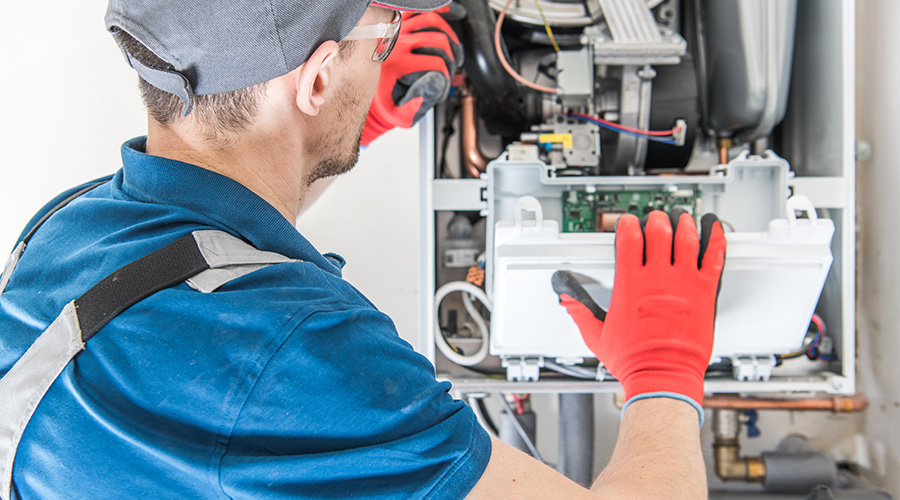HVAC Systems and Mold
Preventing mold, as well as detecting and removing it, requires an understanding of conditions that allow it to form and spread in facilities
A variety of factors can contribute to the growth of mold in institutional and commercial facilities, but one all-too-common culprit is HVAC equipment. The HVAC system, including piping and drain pans, can be sources of mold growth and a transportation mode for dispersing mold spores throughout a building.
Maintenance and engineering managers who understanding the ways that HVAC systems can contribute to mold issues stand a better chance of developing strategies to prevent such problems.
Understanding the Problem
Indoor molds typically are considered a problem when they are visible or when they are amplified or vary in species compared to outside air. Molds generally need water, a food source and the right temperature range to grow.
Indoor environments contain a host of food sources, including drywall, carpeting, cardboard, paper, fabrics, wood and building furnishings. In addition, indoor environments are designed to maintain relative temperatures that are conducive to mold growth.
A manager’s best bet for controlling mold is to control, reduce or eliminate indoor moisture. Active fungal growth can cause building occupants discomfort and irritation, and it can increase the risk of respiratory illness.
Many managers attempt to kill mold with fungicides, biocides and cleaners. This process will kill the mold, but it might not remove the problems. Leaving non-viable mold spores in indoor environments, especially in the HVAC system, might end up complicating indoor air quality (IAQ) complaints. So it is important for managers to develop and implement a pre-emptive plan to prevent mold growth in HVAC systems.
Managers also must understand steps to take — and avoid — when responding to reports of mold in the system. Part of a sound HVAC management plan includes preventing mold growth, responding to reports of mold and an evaluating situations that require professional assistance.
A Lack of Guidance
No federal regulations exist pertaining to mold remediation, but efforts are under way to develop federal mold regulations. Some states also are in the process of enacting legislation governing the licensing of mold-remediation professionals. Several states already have mold regulations, including Texas and Florida.
In the absence of regulations, several agencies, associations and groups have published guidance on steps to prevent, investigate and remediate mold indoors. Several documents address molds and the HVAC system. A few of the more prominent sources, listed in the article on page 17, should be on every manager’s desk.
HVAC Systems: A Closer Look
The proper design, installation and maintenance of the facility HVAC system is essential for controlling indoor mold.
HVAC systems have a significant impact on condensation, a source of moisture for mold. The system can also transport mold spores between areas of a building. Poor design, operation and maintenance of the this system also can provide moisture to support mold growth, and the system can provide a viable transportation mode for mold spores throughout a building.
Key components to check during an HVAC system assessment include these:
Coils and drain pans. Cooling coils dehumidify air and cause condensate water to drip into a drain pan and exit via a deep seal trap. Standing water accumulates if the drain pan is not properly designed and maintained, creating a microbial habitat. Proper sloping and frequent cleaning of drain pans is essential for healthy IAQ.
Humidification and dehumidification equipment. Technicians should drain and periodically treat wet surfaces as necessary to prevent microbial growth, and they should not allow duct linings to become moist from water spray.
Outdoor air dampers. Dust and debris that can support mold growth can obstruct screens and grilles. Cleaning these surfaces regularly can remove dust build-up.
Air filters. Technicians should replace filters regularly, either on the basis of pressure drop across the filter or on a scheduled basis. Technicians also should shut off fans when changing the filter to prevent contamination of the air. Filters should fit tightly in the filter housing.
Higher-efficiency filters are often recommended as a cost-effective means of improving IAQ while minimizing energy use. Product specifiers should match filtration efficiency to equipment capabilities and expected airflows.
Ducts. A small amount of dust on duct surfaces is normal. Parts of the duct most susceptible to contamination include areas with restricted airflow, duct lining and areas subject to moisture or condensation. Technicians should identify and remediate excessively wet areas, including the system’s chronically damp internal lining. Technicians can prevent problems with biological pollutants in the duct work by:
- minimizing dust and dirt build-up, especially during construction or renovation work
- promptly repairing leaks and water damage
- keeping key system components dry
- cleaning coils and drip pans
- performing proper filter maintenance
- performing proper housekeeping in occupied spaces.
Return-air plenum. Engineers often use the space above ceiling tiles a return-air plenum. Man-agers should strictly follow code that restricts material and supplies in the plenum to prevent contamination and insure an uninterrupted airflow. Workers also should remove all dirt and debris from construction activity.
Technicians must vigorously maintain all exhaust systems passing through the plenum to prevent leaks and prevent exhaust from being released into the plenum. Technicians also should check for condensation on pipes in plenum areas.
Cooling towers. Periodically monitoring water quality and chemical treatment to prevent microbial growth is essential for proper IAQ. Physical cleaning to prevent sediment accumulation and installation of drift eliminators also might be necessary.
Air intakes. HVAC technicians should pay attention to areas where outdoor air enters the HVAC system. They also should investigate accumulations of organic material in or near HVAC air intakes. Areas near Dump-sters, garbage cans, boxes, paper, standing rain water, pond, lagoons, freshly disturbed earth and vegetation can contribute to elevated indoor measurements of airborne fungal spores.
These materials includes bird or bat droppings, which support the growth of pathogenic fungi and plant material that generally supports fungal growth. Ex-posure to pigeon droppings on window sills or air conditioning units in urban office buildings has been linked to fungal contamination.
The complex interior structures of commercial HVAC systems provide a host of reservoirs for moisture and mold growth. These areas are difficult to assess and remediate. Managers also can consider an assessment of:
- filters for dampness, microbial growth and dirt
- heat exchangers, such as the cooling coil section including drain pan
- air conditioners for standing water, microbial growth and dirt
- ductwork and air diffusers for dampness, microbial growth, dirt and rust.
Cooling coils are one example of a component that is difficult to inspect and thoroughly clean. Coil fins can buildup excessive mold growth, requiring the use of aggressive cleaners. Some cleaners, however, can cause damage to the coil fins.
High-pressure water spraying also can damage the fins. Improper cleaning can cause damage that affects the overall efficiency of the entire HVAC system.
In-house Responses
Nothing can replace proper design, operation and maintenance of an HVAC system in improving IAQ. To achieve this goal, managers can develop a sound plan to prevent and address mold growth associated with the system. Decreased system performance, filter inefficiency, improper installation and poor maintenance all can contribute to the spread of mold. But even the most diligent manager might find a mold situation that requires clean-up.
Manager also can benefit from understanding several key principles when mold clean-up becomes necessary.
First, they should use only trained and competent workers. A competent worker is defined as one having not only proper training and knowledge but also the right behavioral capacity to use that knowledge.
Managers looking for guidance on using in-house staff might consider a timely new document. In May, the National Institute of Environmental Health and Sciences issued, Guidance for the Protection and Training of Workers Engaged in Maintenance and Remediation Work Associated With Mold. The document addresses worker safety and work practices for in-house mold clean-up.
Second, technicians using proper work methods should remove or clean the colonized materials and settled dust that might contain previously dispersed mold spores. Disinfectants and cleaners for the HVAC system include EPA-registered formulas for equipment disinfection and cleaning.
This process also can include the use of stabilized chlorine dioxide-oxine or an approved equivalent. Fungicidal protective coatings include EPA-registered polyacrylate emulsions formulated for long-term fungicidal activity and HVAC application.
Finally, workers should use cleaning methods that offer protection and do not spread mold spores to non-affected areas. These methods include using proper personal protective equipment, isolation procedures, and decontamination methods to protect workers and avoid tracking contamination outside of the work area.
Outside Assistance
Mold growth in HVAC systems is one area in which the use of a mold-remediation professional might be beneficial. No consensus definition exists for a qualified mold professional. Finding a professional who understands the unique issues and complexities of HVAC system contamination is a greater concern. Mold-remediation professionals working on HVAC systems might need a mold remediation license in certain states. They also might need a license to clean HVAC systems.
Managers should check their operating procedures, safety procedures, training and certifications. Those lacking any of these items or who cannot describe the contents of these documents should raise a red flag.
Finally, managers need to make sure the insurance they carry specifically covers fungal remediation by having the insurance, risk management or legal department verify appropriate coverage.
Proper design, operation and maintenance of an HVAC system will go a long way to preventing or reducing mold issues. Understanding the HVAC components and conditions support mold growth, as well as steps that prevent mold growth in these areas, are essential information for managers looking to both prevent and remediate mold problems.
Essential Reading: HVAC and Mold
The resources below offer maintenance and engineering managers guidance when addressing mold-related problems:
|
Jeffery C. Camplin CSP, CPEA — mundycamp@aol.com — is president of Camplin Environmental Services Inc. in Rosemont, Ill. He is the administrator of the American Society of Safety Engineers environmental practice specialty, where he participates on their ANSI Mold Worker Protection Standard committee.
Related Topics:











